
Fairfax’s classified advertising — its rivers of gold — was always what funded most of the costs of printing its papers. And while Fairfax has lost control of most of these advertising flows, the one pot it still has its fingers in provides enough revenue to keep the papers printed — some of them, for now.
This month, Fairfax CEO Greg Hywood floated the idea of reducing the publishing profile and frequency of The Sydney Morning Herald and The Age.
In a speech to a Sydney finance conference earlier this month, Hywood said:
“In the case of the SMH and The Age, the newspapers could potentially offer a differentiated consumer experience designed for the weekend … This fits with what consumers want — 24/7 digital and print with more lifestyle and contextual information on the weekend when there is more time to engage.”
“Across the developed world we are seeing deep changes to the traditional seven-day-a-week publishing model that signals a new future: 24/7 digital and reduced print frequency.”
Hywood said Fairfax would inevitably move to a new business model for its metropolitan newspapers, though it could be some time away. He added that the company had been drawing up the potential changes as it monitored international trends, rather than the local industry. He told the conference that the company had cut the prospective cost of closing its metro publishing operations, both print and online, from $450 million four years ago to $150 million today. Hywood foresees a possible outcome where the revenue model for the SMH and The Age is “reset to focus on the 65% of advertising revenue, which is generated on the weekend”. The Financial Review print edition would “likely focus on its weekday revenue strength”, he added.
What is this 65% of advertising revenue generated on the weekends? What Hywood is really talking about is the company’s increasing dependence on property ads via real estate portal and print section Domain. Domain appears in the Saturday SMH and Age and in the Sunday Age and Sun Herald. For the AFR there’s the Wednesday prestige property insert, and the usual weekly Domain insert in the AFR on Friday. The Sunday editions of the metro papers carry extensive results coverage of the previous day’s (and week’s) sales and are extensively linked to the Domain website.
The weekends aren’t just when the advertisers want to be in print — they’re also when the readers are most likely to pick up the paper.
The SMH sold an average of 115,415 copies on Mondays in the quarter, 99,686 on Tuesdays, 96,341 on Wednesdays, 95,693 on Thursdays, 104,260 on Fridays and 191,728 on Saturdays. The average figure for the Sun Herald for the quarter was 196,060.
For The Age the figures are: 87,373 on Mondays, 91,221 on Tuesdays, 87,760 on Wednesdays, 118,439 on Thursdays , 92,512 on Fridays and 164,774 on Saturdays. The Sunday Age sold an average of 133,562 in the quarter. And for the AFR the figures are 47,545 on Mondays, 48,020 on Tuesdays, 49,307 on Wednesdays, 49,150 on Thursdays, 57, 507 on Fridays and 62,345 on Saturdays.
Hywood’s comments about 65% of ad revenues at the weekend is clearly based on the weekend property auction/sales cycles.
Do readers look at these property ads in the weekend papers? Perhaps, but surely to a far lesser extent than they go searching for new homes through online search portals like Domain and market leader realestate.com.au (64% owned by rival News Corp).
But property advertising is different to most types of advertising in that it’s paid for by those selling their homes, who pay standardised marketing packages from their agents that include placement in a paper. And agents love being in print; it puts their name up in lights almost as much as it advertises the properties they’re selling. While this dynamic remains, there’ll always be money for Fairfax in printing the paper. At least, on the days the agents are willing to pay for it.







As it seems likely Fairfax might eventually print only Saturday editions of the Age and Sydney morning herald,,,,a friendly warning to subscribers…Do NOT take out a prepaid long term subscription. When fFairfax increased cover prices and subscription rates and removingSeniorsrates..I accepted a annual ratenpaid in advance. When my newsagent stopped home delivery No refund from Fairfax. Be warned…..Dennis
I can’t remember the last time I perused the real estate section of the Age on weekends. I do read the print version on weekends when having a lazy brunch or a coffee or three at a local cafe. With the exception of Thursday’s Age (the Green Guide… a once useful addition to the home but now slipping into sad decline) the rest of the weekday editions are hemorrhaging.
Catch any morning suburban train, tram or bus and I guarantee 90% of people reading a paper would be on their phone or iPad or laptop unlike say 10 years ago when the rustle of pages was almost in tune with the on board announcements.
I don’t think real estate revenue is the panacea Fairfax is looking for. They need to find a point of different that people (a) want to subscribe to electronically during the week and (b) perhaps buy in paper form on the weeekend. If Fairfax is going to be 24/7 then they need to demonstrate this as pretty much the online versions go to sleep most evenings with the inevitable click bait stories which are more suited to tabloid garbage like the Herald Sun or DT.